
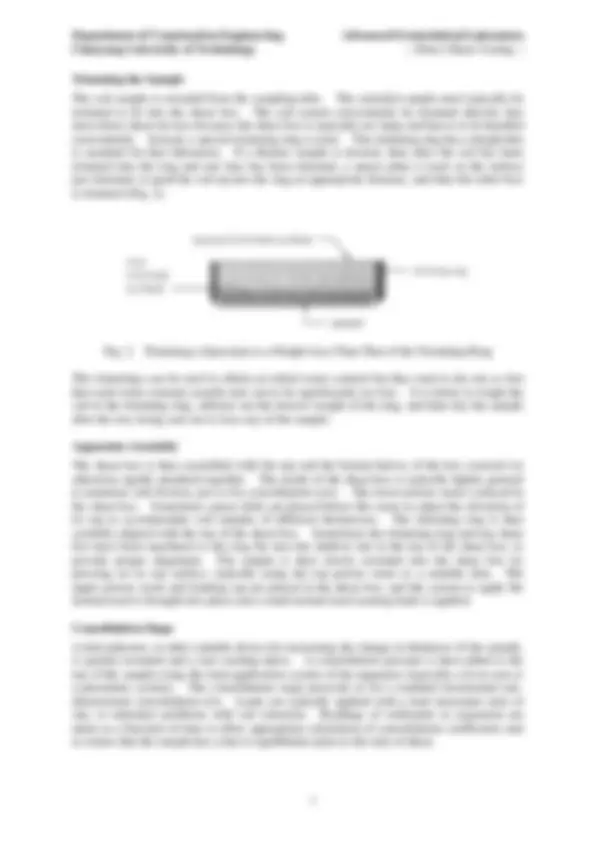
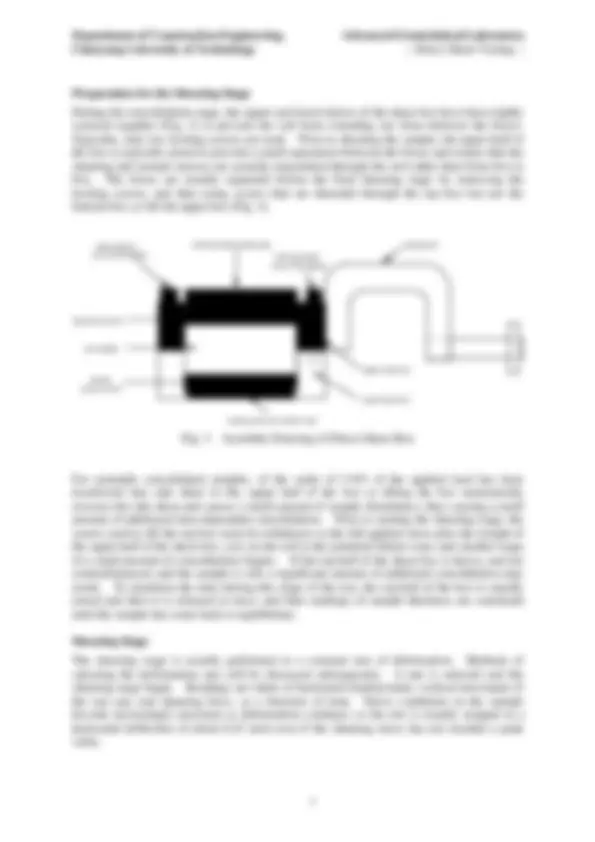
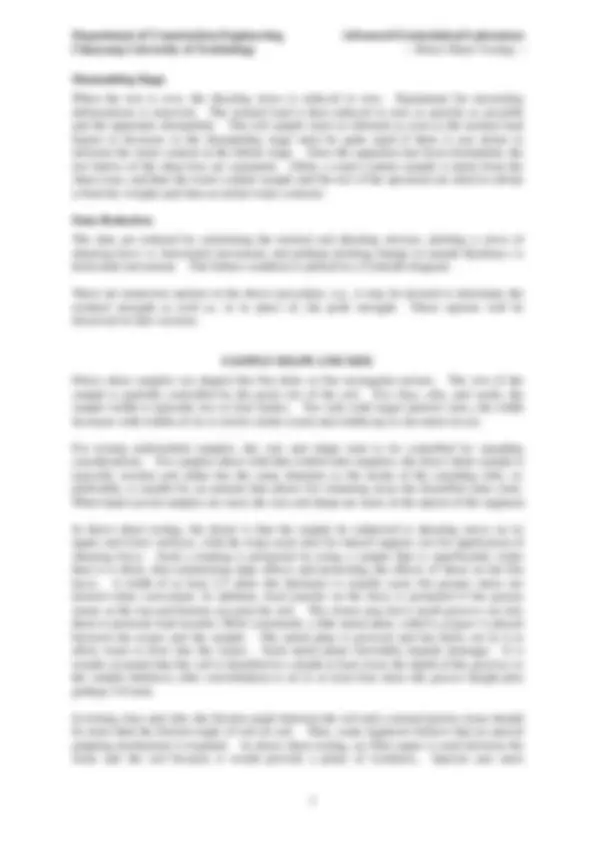
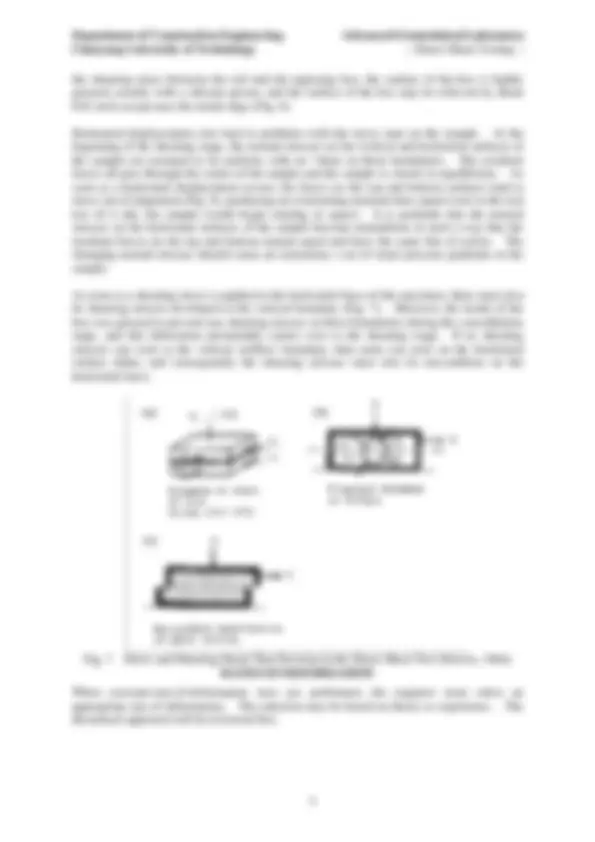
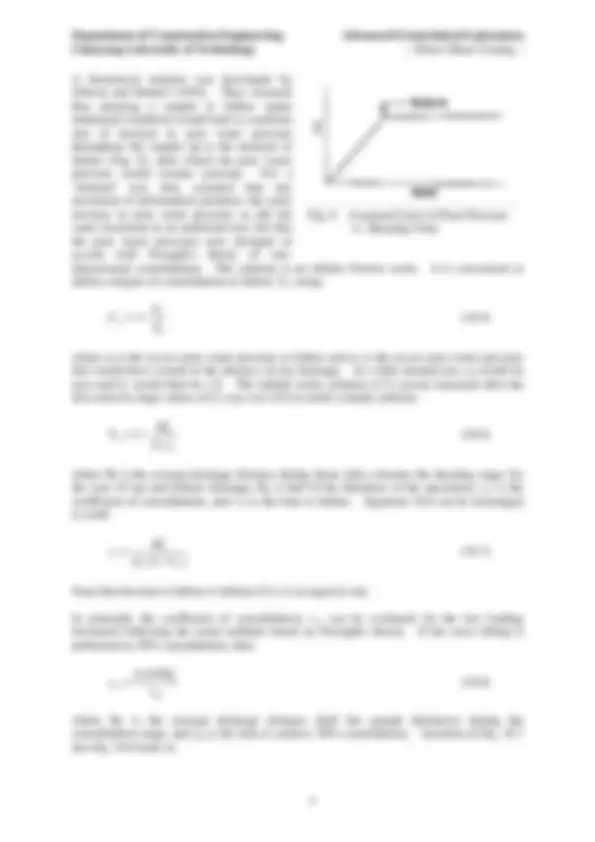
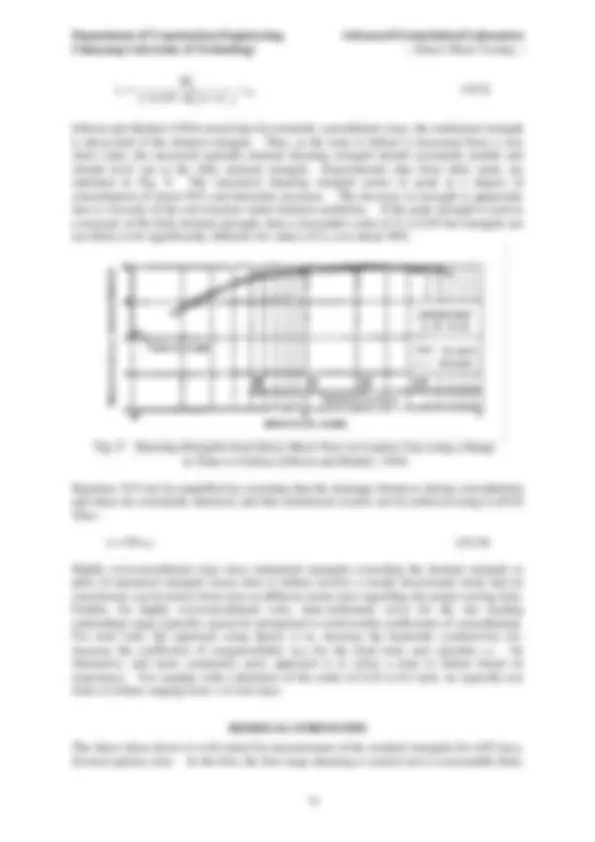
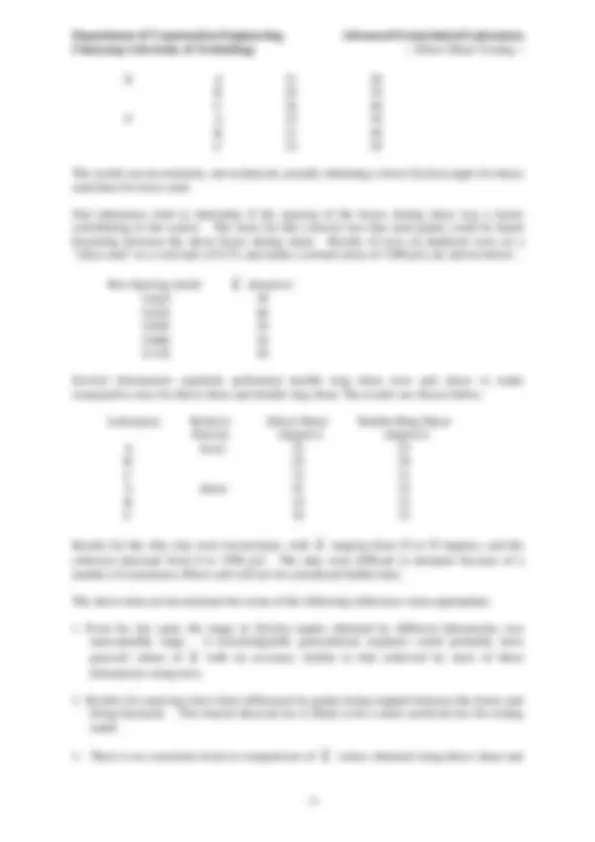
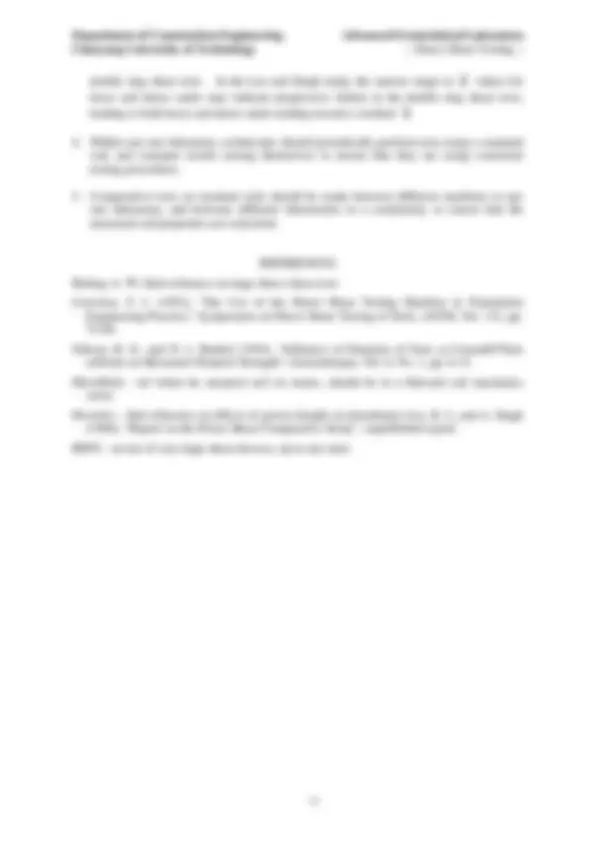


Study with the several resources on Docsity

Earn points by helping other students or get them with a premium plan


Prepare for your exams
Study with the several resources on Docsity

Earn points to download
Earn points by helping other students or get them with a premium plan
Community
Ask the community for help and clear up your study doubts
Discover the best universities in your country according to Docsity users
Free resources
Download our free guides on studying techniques, anxiety management strategies, and thesis advice from Docsity tutors
Direct shear test analysis and notes
Typology: Study notes
1 / 14

This page cannot be seen from the preview
Don't miss anything!









Chaoyang University of Technology -- Direct Shear Testing --
Prepared by Dr. Roy E. Olson on Fall 1989 Modified by Jiunnren Lai on Spring 2004
______
The direct shear device is used to determine failure envelopes for soils. The device is not suitable for determination of stress-strain properties of soils. Various aspects of the device and resulting data have been discussed previously and will not be repeated.
Most of this chapter will be written with the assumption that the tests are of the fully drained type. A later section will cover undrained testing.
Direct shear testing is covered in ASTM standard D-3080, "Standard Method for Direct Shear Test on Soils under Consolidated Drained Conditions".
A cross section through a typical direct shear device is shown in Fig. 1. The soil sample has a porous stone at the top and bottom to allow free drainage (impervious plates could be used for "undrained" tests). Above the upper stone is a metal loading cap which is, in turn, subjected to the normal force. The sample and rings are mounted in a tank which is typically filled with water, but will be empty if tests are being performed on "unsoaked" soil. Several device configurations are in use but, typically, the shearing force is applied to the outside of the tank, which is on rollers (Fig. 1). The tank transmits the load to the lower porous stone and hence to the lower part of the sample. Load is then transferred through the shearing surface to the top part of the system and hence to a load measuring device.
Most laboratory direct shear tests are performed on samples with widths of the order of two to three inches. However, samples up to a meter in width have been used for soils containing gravel-sized particles (Nonveiller, 1954; Schultze, 1957; Bishop, __).
Introduction
The overall testing procedure will be reviewed first, without covering details, and then each aspect of the test will be considered separately. It is assumed that the test is to be fully drained and the sample is undisturbed and cohesive, and is in a sampling tube. Minor modifications cover other cases.
Chaoyang University of Technology -- Direct Shear Testing --
Chaoyang University of Technology -- Direct Shear Testing --
Preparation for the Shearing Stage
During the consolidation stage, the upper and lower halves of the shear box have been tightly screwed together (Fig. 3) to prevent the soil from extruding out from between the boxes. Typically, only two locking screws are used. Prior to shearing the sample, the upper half of the box is typically raised to provide a small separation between the boxes and ensure that the shearing and normal stresses are actually transmitted through the soil rather than from box to box. The boxes are usually separated before the final shearing stage by removing the locking screws, and then using screws that are threaded through the top box but not the bottom box, to lift the upper box (Fig. 3).
existing aluminum bottom disk
stainless steel loading cap
soil sample
top porous stone
bottom porous stone
locking screws two at 180 degree
lifting screws two at 180 degree
upper shear box
lower shear box
loading arm
Fig. 3 Assembly Drawing of Direct Shear Box
For normally consolidated samples, of the order of 5-8% of the applied load has been transferred into side shear in the, upper half of the box so lifting the box momentarily reverses the side shear and causes a small amount of sample disturbance, thus causing a small amount of additional time-dependent consolidation. Prior to starting the shearing stage, the screws used to lift the top box must be withdrawn so the full applied stress plus the weight of the upper half of the shear box, acts on the soil in the potential failure zone, and another stage of a small amount of consolidation begins. If the top half of the shear box is heavy, and not counterbalanced, and the sample is soft, a significant amount of additional consolidation may result. To minimize the time during this stage of the test, the top half of the box is usually raised and then it is released at once; and then readings of sample thickness are continued until the sample has come back to equilibrium.
Shearing Stage
The shearing stage is usually performed at a constant rate of deformation. Methods of selecting the deformation rate will be discussed subsequently. A rate is selected and the shearing stage begin. Readings are taken of horizontal displacement, vertical movement of the top cap, and shearing force, as a function of time. Stress conditions in the sample become increasingly uncertain as deformation continues so the test is usually stopped at a horizontal deflection of about 0.25 inch even if the shearing stress has not reached a peak value.
Chaoyang University of Technology -- Direct Shear Testing --
Dismantling Stage
When the test is over, the shearing stress is reduced to zero. Equipment for measuring deformations is removed. The normal load is then reduced to zero as quickly as possible and the apparatus dismantled. The soil sample starts to rebound as soon as the normal load begins to decrease so the dismantling stage must be quite rapid if there is any desire to measure the water content at the failure stage. Once the apparatus has been dismantled, the two halves of the shear box are separated. Often, a water content sample is taken from the shear zone, and then the water content sample and the rest of the specimen are dried to obtain a final dry weight (and thus an initial water content).
Data Reduction
The data are reduced by calculating the normal and shearing stresses, plotting a curve of shearing force vs. horizontal movement, and perhaps plotting change in sample thickness vs horizontal movement. The failure condition is plotted in a Coulomb diagram.
There are numerous options in the above procedure, e.g., it may be desired to determine the residual strength as well as, or in place of, the peak strength. These options will be discussed in later sections.
Direct shear samples are shaped like flat disks or flat rectangular prisms. The size of the sample is partially controlled by the grain size of the soil. For clays, silts, and sands, the sample width is typically two to four inches. For soils with larger particle sizes, the width increases with widths of six to twelve inches usual and widths up to one meter in use.
For testing undisturbed samples, the size and shape tend to be controlled by sampling considerations. For samples taken with thin-walled tube samplers, the direct shear sample is typically circular and either has the same diameter as the inside of the sampling tube, or, preferably, is smaller by an amount that allows for trimming away the disturbed outer zone. When hand carved samples are used, the size and shape are more at the option of the engineer.
In direct shear testing, the desire is that the sample be subjected to shearing stress on its upper and lower surfaces, with the rings used only for lateral support, not for application of shearing force. Such a loading is promoted by using a sample that is significantly wider than it is thick, thus minimizing edge effects and promoting the effects of shear on the flat faces. A width of at least 2.5 times the thickness is usually used, but greater ratios are desired when convenient. In addition, load transfer on the faces is promoted if the porous stones at the top and bottom can grip the soil. The stones may have small grooves cut into them to promote load transfer. More commonly, a thin metal plate, called a gripper is placed between the stones and the sample. The metal plate is grooved and has holes cut in it to allow water to flow into the stones. Such metal plates inevitably impede drainage. It is usually assumed that the soil is disturbed to a depth at least twice the depth of the grooves so the sample thickness after consolidation is set to at least four times the groove height plus perhaps 1/8 inch.
In testing clays and silts, the friction angle between the soil and a normal porous stone should be more than the friction angle of soil on soil. Thus, some engineers believe that no special gripping mechanism is required. In direct shear testing, no filter paper is used between the stone and the soil because it would provide a plane of weakness. Special care must
Chaoyang University of Technology -- Direct Shear Testing --
7
Fig. 5 Stress Path from Direct Shear Tests
Fig. 6 Cross Section Through the Edge of a Direct Shear Box
As the test progresses, the area of soil-to-soil contact diminishes. For a square sample with horizontal dimensions of BxB, subjected to a horizontal displacement of ∆ h, the actual area of contact is B(B- ∆ h). The corrected area, A, can be expressed in terms of the original area, A 0 =BxB, using an area correction factor, F:
A = A 0 F (18.1)
where:
h F 1
For a circular sample, displacement leads to contact through the hatched area shown in Fig. 4. For a sample of diameter D, the original area is given by:
2 A 0 4 D π = (18.3)
The correction factor for area becomes:
2 (^2) cos (^1 ) D
h D
h D
h F
where the arc-cosine is in radians. Numerical values of the correction factor are as follows:
The normal force is typically constant during a direct shear test so the reduction in area leads to a gradual increase in normal stress. The shearing force is found by dividing the applied force by the corrected area A. The stress path, then, is not a vertical line but is actually a line that curves to the right, as shown in Fig.
Fig. 4 Contact Area of the Sample
Chaoyang University of Technology -- Direct Shear Testing --
the shearing stress between the soil and the opposing box, the surface of the box is lightly greased, usually with a silicone grease, and the surface of the box may be relieved by about 0.01 inch except near the inside edge (Fig. 6).
Horizontal displacements also lead to problems with the stress state on the sample. At the beginning of the shearing stage, the normal stresses on the vertical and horizontal surfaces of the sample are assumed to be uniform, with no "shear on these boundaries. The resultant forces all pass through the center of the sample and the sample is clearly in equilibrium. As soon as a horizontal displacement occurs, the forces on the top and bottom surfaces tend to move out of alignment (Fig. 8), producing an overturning moment that cannot exist in the real test (if it did, the sample would begin rotating in space). It is probable that the normal stresses on the horizontal surfaces of the sample become nonuniform in such a way that the resultant forces on the top and bottom remain equal and have the same line of action. The changing normal stresses should cause an extraneous s set of water pressure gradients in the sample.
As soon as a shearing stress is applied to the horizontal faces of the specimen, there must also be shearing stresses developed at the vertical boundary (Fig. 7). However, the inside of the box was greased to prevent any shearing stresses at these boundaries during the consolidation stage, and this lubrication presumably carries over to the shearing stage. If no shearing stresses can exist at the vertical soil/box boundary, then none can exist on the horizontal surface either, and consequently the shearing stresses must also be non-uniform on the horizontal faces.
Fig. 7 Stress and Shearing Strain That Develop in the Direct Shear Test (Sowers, 1964) RATES OF DEFORMATION
When constant-rate-of-deformation tests are performed, the engineer must select an appropriate rate of deformation. The selection may be based on theory or experience. The theoretical approach will be reviewed first.
Chaoyang University of Technology -- Direct Shear Testing --
50 f
2 C
2 S f (^20). 197 H ( 1 U ) t
t ⋅ ⋅ ⋅ −
Gibson and Henkel (1954) noted that for normally consolidated clays, the undrained strength is about half of the drained strength. Thus, as the time to failure is increased from a very short value, the measured partially drained shearing strength should essentially double and should level out at the fully drained strength. Experimental data from their study are replotted in Fig. 9. The measured shearing strength seems to peak at a degree of consolidation of about 95% and thereafter decrease. The decrease in strength is apparently due to viscosity of the soil structure under drained conditions. If the peak strength is used as a measure of the fully drained strength, then a reasonable value of Uf is 0.95 but strengths are not likely to be significantly different for values of Uf over about 90%.
Fig. 9 Shearing Strengths from Direct Shear Tests on London Clay using a Range in Times to Failure (Gibson and Henkel, 1954)
Equation 18.9 can be simplified by assuming that the drainage distances during consolidation and shear are essentially identical, and that satisfactory results can be achieved using Uf =0.95. Thus:
t (^) f = 50 t 50 (18.10)
Highly overconsolidated clays have undrained strengths exceeding the drained strength so plots of measured strength versus time to failure involve a steady downwards trend and no conclusions can be drawn from tests at different strain rates regarding the proper testing time. Further, for highly overconsolidated soils, time-settlement curve for the last loading (unloading) stage typically cannot be interpreted to yield useful coefficients of consolidation. For such soils, the approach using theory is to, measure the hydraulic conductivity (k), measure the coefficient of compressibility (aV) for the final load, and calculate cV. An alternative, and more commonly used, approach is to select a time to failure based on experience. For samples with a thickness of the order of 0.25 to 0.5 inch, we typically use times to failure ranging from 1 to four days.
The direct shear device is well suited for measurement of the residual strengths for stiff clays. Several options exist. In the first, the first stage shearing is carried out to a reasonable limit,
Chaoyang University of Technology -- Direct Shear Testing --
say 0.25 inch of horizontal movement. Then the direction of shearing is reversed and carried to a total deflection of -0.25 inch. This process is repeated until the measured strength remains essentially constant for several cycles. Typically, reversal of shear causes a sudden increase in the shearing stress and then a decrease back to a relatively steady value, even after numerous cycles of loading. The residual strength is taken as that steady value.
An alternative approach that saves a great deal of time, is to precut a failure surface at the position corresponding to the contact between the two halves of the shear box, and run one or two cycles on it. The surface may be smoothed using a wide putty knife, or other suitable tool, to get it as smooth as practicable prior to be start of the test.
In some cases, a specimen can be trimmed from a slickensided sample in such a way that the natural shear surface is aligned with the shear surface in the shear box and direct shear tests can be performed on the actual slickensided surface.
An undrained test is one in which the water content in the failure zone does not change during shear. Direct shear tests on clays can be performed fast enough that only relatively small volume changes occur in the sample as a whole. However, shearing stresses, and thus the excess pore water pressures, tend to be concentrated in the shearing zone, and thus not to pervade the entire sample thickness. Water may migrate out of the shear zone and into the rest of the sample, or vice versa, during shear even though the overall change in average water content of the sample is apparently negligible. Such a test is not truly undrained. The same problem exists in the case of triaxial compression tests when failure occurs on a single plane.
An alternative approach is to adjust the axial load to maintain a constant sample thickness during shear. If carried out with sufficient precision, such an approach may maintain the overall water content constant but I does not ensure that water migration will not occur within the sample.
Attempts to seal the sample by using impervious end caps, similarly does not prevent internal migration of moisture.
The direct shear device, by its very nature, is not suitable for undrained tests and should not be used for that type of strength testing.
We have used drained direct shear tests to estimate shearing properties of clay shales for slope stability analyses, for several decades, and find that the accuracy of field conditions is apparently controlled by factors unrelated to details of the laboratory test, especially to prediction of pore water pressures in the field, to accounting for effects of non-homogeneous soils, and for analytical methods. The direct shear apparatus itself thus seems to give results with more accuracy than we actually need.
On the other hand, there have been a few studies in which direct shear failure envelopes were compared with envelopes from triaxial or other types of shear tests, or the results from direct shear tests in one laboratory are compared with data from another laboratory.
Chaoyang University of Technology -- Direct Shear Testing --
The results are inconsistent, one technician actually obtaining a lower friction angle for dense sand than for loose sand.
One laboratory tried to determine if the spacing of the boxes during shear was a factor contributing to the scatter. The basis for this concern was that sand grains could be heard fracturing between the shear boxes during shear. Results of tests on duplicate tests on a "silica sand" at a void ratio of 0.75, and under a normal stress of 1500 psf, are shown below:
Box Spacing (inch) φ (degrees) 0.025 39 0.035 40 0.045 39 0.066 38 0.126 36
Several laboratories regularly performed double ring shear tests and chose to make comparative runs for direct shear and double ring shear. The results are shown below:
Laboratory Relative Direct Shear Double Ring Shear Density (degrees) (degrees) A loose 35 25 B 29 28 C 33 31 A dense 42 32 B 34 33 C 36 33
Results for the silty clay were inconsistent, with φ ranging from 25 to 55 degrees, and the cohesion intercept from 0 to 1500 psf. The data were difficult to interpret because of a number of extraneous effects and will not be considered further here.
The above data are inconsistent but some of the following inferences seem appropriate:
Chaoyang University of Technology -- Direct Shear Testing --
double ring shear tests. In the Lee and Singh study, the narrow range in φ values for loose and dense sands may indicate progressive failure in the double ring shear tests, leading to both loose and dense sands tending toward a residual φ.
Bishop, A. W. (find reference on large direct shear tests
Converse, F. J. (1952), "The Use of the Direct Shear Testing Machine in Foundation Engineering Practice," Symposium on Direct Shear Testing of Soils, ASTM, Vol. 131, pp. 75-80.
Gibson, R. E., and D. J. Henkel (1954), "Influence of Duration of Tests at ConstahTTlate orStrain on Measured 'Drained' Strength", Geotechnique, Vol. 4, No. 1, pp. 6-15.
Hirschfeld - ref where he smeared soil on stones, should be in a Harvard soil mechanics series
Hvorslev - find reference on effects of groove height on disturbance Lee, K. L, and A. Singh (1968), "Report on the Direct Shear Comparative Study", unpublished report.
REFS - on use of very large shear devices, up to one mete